The art installation, Salmon School, places the plight of salmon and steelhead right before people's eyes through a "school" of blown glass fish hanging from the ceiling, absorbing the viewer imaginatively into their life and movements within a river. The creator, Joseph Rossano, a resident of Washington State, was inspired to create this installation by the dwindling runs of salmon and steelhead in the Skagit River Valley, where he lives.
The Skagit River, the fourth largest outflow to the Pacific Ocean in the continental United States, is experiencing steep declines in its salmon and steelhead populations. Salmon stocks which once numbered in the millions have dropped to tens of thousands, and the steelhead population, which once numbered in the tens of thousands, has dropped into the hundreds. As bellwether species of the ecosystems, the declining numbers of salmon and steelhead are not just indications of the trouble they themselves are facing, but also indicators of troubles within the larger ecosystem.
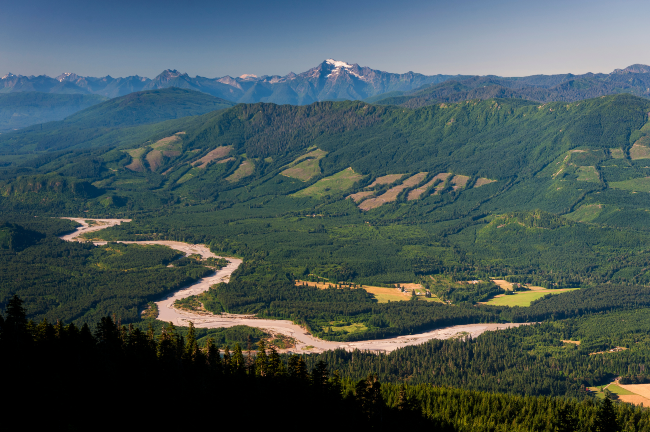
Group Project
When Rossano conceived of Salmon School, he also conceived of the idea of "crowdsourcing" the project. Rather than producing all the glass fish himself, Rossano invited glass artists, scientists, and others in the community to contribute to the exhibition.
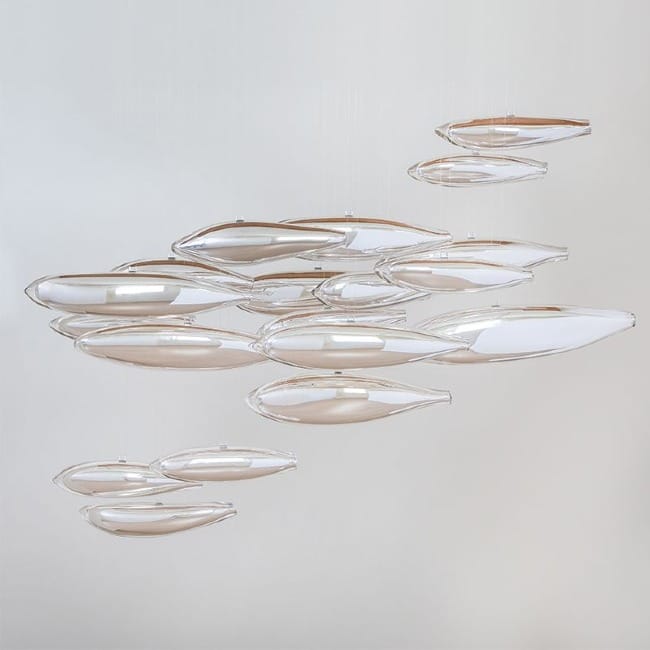
To get the project started, in the summer of 2018, Rossano sent letters out to a worldwide group of fellow artists, inviting their involvement. That fall, around 75 glassblowers from different parts of the world responded, coming to the Museum of Glass in Tacoma, Washington to participate in creating glass fish for an exhibit, which would later open at the Bellevue (WA) Museum of Art. This specific event led to creation of around 300 of the fish forms.
The event was the first of a series of making events held in various venues around Washington and elsewhere. In addition to the in-person glass making events, Rossano invited glassmakers from around the world to create the glass fish in their own studios, using specific instructions that were sent to them so that all the fish were alike. Once they had made the fish, they sent them back to Rossano who silvered them (silvering is the chemical process of coating a surface such as glass with a reflective substance in order to produce a mirror).
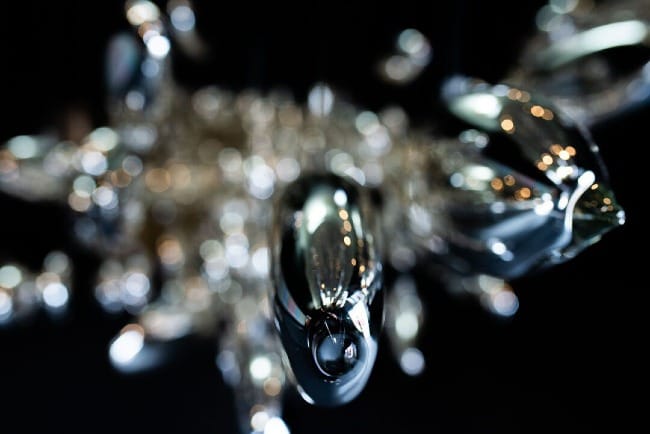
The installation was on display at the Bellevue Arts Museum from April 12-August 11, 2019. The fish, displayed at eye-level, immersed viewers in the reflection of native wild salmon in the Skagit, and in some ways brought them directly into the flow of those fish and their movement within the "river."
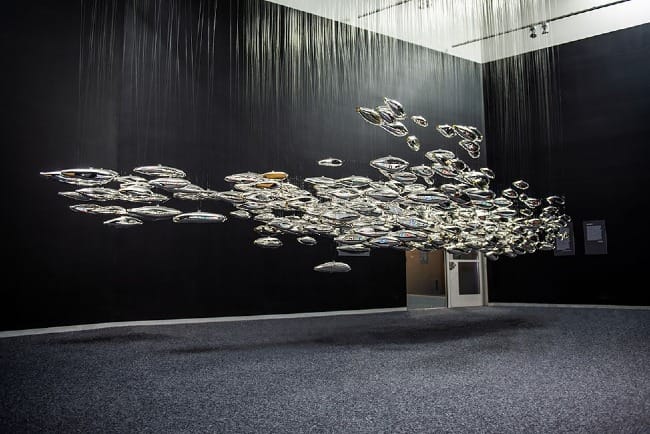
The School Moves to COP26 and Beyond
Following this exhibition, Rossano was approached by The Missing Salmon Alliance to work with a consortium of NGOs (Non-governmental agencies) from around the world to bring Salmon School to the United Nations Climate Change Summit (COP26), where it was installed as a fixture in the main Blue Zone dining area during the summit. In this setting, Salmon School and its accompanying messaging were viewed by thousands of delegates every day during the two-week conference.
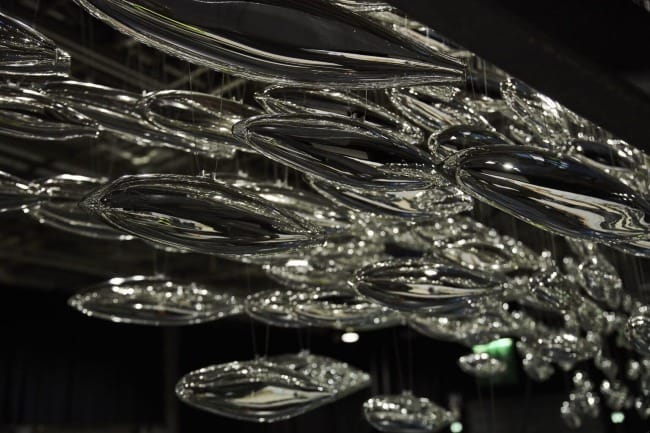
In addition to the life-size school of mirrored salmon, which are sculpted from molten glass, the installation also features first-hand video accounts from renowned scientists, artists, and native peoples. Because the steelhead return to the Skagit in the late winter when food was traditionally scarce, they were an important food supply for indigenous peoples. The stories of the region’s people and their use of its land over thousands of years offers insights and ideas for action that Rossano hopes will bring disparate groups together for the benefit of these fish and those dependent on them.
As the exhibition continues travels to new regions, its narrative expands to include the particular issues faced by that region’s local fish and rivers, as well as providing information and insight into the diminishment of the global populations of salmon and steelhead.
Currently, this exhibition is now the centerpiece of a Platinum Jubilee exhibition of Queen Elizabeth's 70th year as queen, within Balmoral Castle in Scotland, in recognition of the salmon conservation work that has been supported by The Queen, the Royal Family and the Balmoral Estate on the River Dee over the last 170 years.
The Salmon School will continue to move throughout the United Kingdom until late 2023, when it will return to the Pacific Northwest, where it will act as an ambassador for the United Nations Decade of the Ocean and the 2022 United Nations International Year of Glass at the Museum of Glass.
Takeaway Lessons
A specific goal of the exhibition was the creation of 2,504 fish for the exhibit to represent the estimated lowest total to date of annual steelhead returning to the Skagit River. (This low count of 2,504 occurred in 2009; 2020 was a very low year, also). The purpose of creating this representative number of fish in community was to demonstrate how a group of concerned individuals can work together to instigate recovery and thus inspire others to work together to create positive change.
The exhibition has spawned an organization called The Salmon School that partners with politicians, philanthropists, organizations, educators, and indigenous people to work for the change that is needed to protect the fish populations of our rivers. The work to create the exhibit is a picture of how this change can happen and why it must. "This collaboration mirrors the collective, grassroots-driven approach that the world must take to combat climate change and achieve the goals of COP26. Climate change knows no boundaries, and neither do salmon. Everyone has a stake in salmon health because they are the embodiment of healthy rivers and oceans. The energy behind School reflects both the urgency and the hope of this moment on Earth."
To offset the high energy required both to create the exhibition and then to transport it to various locations, the Salmon School has invested in a tree planting program on the river Tweed. Five hundred meters (545 yards) of riverbank were planted with native species in the spring of 2022 to improve conditions for juvenile salmon. Even with the use of recycled and batched glass, glass production is energy-intensive. For instance, according to The Salmon School's website, this installation's life cycle energy consumption produces about 38 tons of carbon dioxide equivalent emissions, equal to the emissions of four households over one year in the United Kingdom. The glass was made over 4.5 years, echoing the lifecycle of salmon.
Because of the interconnected nature of this created world, both negatively and positively, our small and large acts affect the wider world's ecosystem and wellbeing. In other words, both singly and jointly, our actions matter. Living in this consciousness can be an exciting challenge, especially if we believe that the influence of positive actions can spread in the same way that the influence of negative actions can. Can you think of one action you can take to help your own place in the ecosystem become healthier?
I would love to hear from you either through the comment link below or directly at info@circlewood.online
Louise

